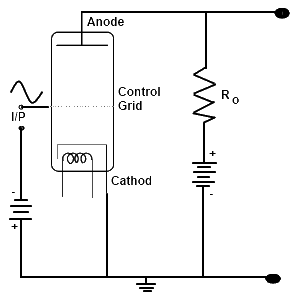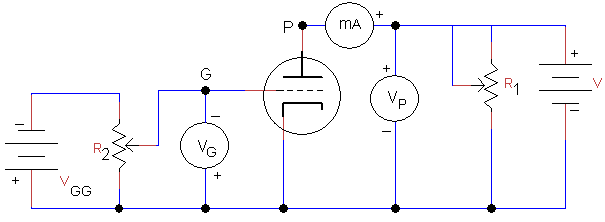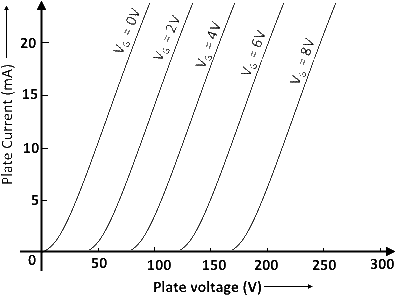Vacuum Tube Triode
Triode is a vacuum tube with three electrodes which are cathode, Anode and a control grid. The function of additional third electrode is to serve as an electrostatic screen which shield the cathode from the electrostatic field of anode triode are used for amplification of weak AC signals of frequency ranging from 0 to 100 MHz.

Triode Working

If the grid is made more negative, then the cathode some of the electrons going towards the plate will be repelled by the grid. Thus reducing the plate current by making the grid more negative it is possible to reduce the plate current to zero. This condition is called cut off.
If a varying signal voltage is applied to the grid the number of electrons flowing in the plate circuit will vary in the same manner as the signal voltage and absence of signal voltage a steady plate current IB will flow. During the negative potion of the signal voltage the grid becomes more negative because grid bise and signal voltage have same polarity at that time as a result plate current decreases. During the positive portion of the input signal the polarity of input signal and that of the grid is opposite hence the plate current will be in phase with the variation in the signal voltage. But output voltage variation will be out of phase by 180o with the signal voltage variation.
Alternating Voltage to Grid
If a varying signal voltage is applied to the grid, the number of electrons flowing in the plate circuit will vary in the same manner as the signal voltage and in the absence of a signal voltage a steady plate current Ip will flow. If the alternating signal voltage whose maximum value does not becomes less negative during the positive portion of the input signal because they have opposite polarity. Hence plate current will increase to valve high than Ip. During the negative portion of the signal voltage the grid becomes more negative because grid bias and signal voltage have same polarity at that time as a result plate current decreases to valves below Ip.
It should be observed that the instantaneous variation in plate current will be in phase with the variation in the signal voltage. But output voltage variation will be out of phase by 180° with the signal voltage variations. The reason is the output voltage is equal to the voltage of battery B minus the voltage drop ER0 therefore as the plate current increases the output voltage decreases because more voltage drop across Ro and vice versa.
WHY WE MAKE GRID BIAS NEGATIVE
There are two major reasons to make grid bias generally negative:
- Current flowing in the grid circuit can distort the shape of the output voltage with respect to the shape of the input voltage.
- Positive grid voltage can cause excessive plate current and result in damage to the tube.
Characteristic Curve of Triode
The characteristic curves are used to determine the performance of a tube under any operating condition.

The characteristics can be obtained by using the circuit as shown in Figure (a). First let us adjust the grid voltage at zero volts. Now plate voltage increased in steps and the corresponding values of plate current are noted at each step. If we draw a graph between plate voltage and plate current, then a curve is obtain at VG = O. Similarly obtain curve at VG = —2, —4V, —6V,—8V and so on.

Curve in Figure (b) showing the variation in plate current for changes in plate voltage with different grid voltages. It is called plate characteristic curves. VG represents grid voltage.
Plate Resistance (rp)
It is the ratio small change in plate voltage Vp to the small change in plate current Ip when grid voltage Vg is kept constant. It is generally denoted by rp
rp = (∆Vp/∆Ip) (at Vg constant)
The value of rp can be obtain from the plate characteristic and its value remains constant along the linear portion of the characteristic.
Amplification Factor (p)
The ratio of small change in plate voltage vp to the small change in the grid voltage vg when plate current Ip is kept constant is called amplification factor. It is generally denoted µ
µ = — (∆Vp/∆Vg) (at constant Ip)
As Vp and Vg are changed in opposite direction to keep Ip constant, therefore the ratio ∆Vp/∆Vg is negative sign appearing in the formula for µ to make this ratio positive.
Mutual Conductance gm (Transconductance)
The ratio of small change in plate current Ip to the small change in grid voltage vg when plate voltages vp is kept constant is called mutual conductance or transconductance and it is denoted by gm.
gm = ∆Ip/∆Vg (at constant Vp)
Relation between rp, m and gm
As we know that:
rp = ∆Vp/∆Vg --------------------(I)
µ = ∆Vp/∆Vg -----------------(II)
Multiply equation (I) and equation (II)
rp X gm = (∆Vp/∆Ip) X (∆Ip/∆Vg)
rp X gm = ∆Vp/∆Vg = µ
m = rp X gm
